
















This Get Ready Guide is designed to help you prepare for disasters. This important document offers current planning information and contact phone numbers.
The Chronicle, The Chief, The Tillamook Headlight Herald and North Coast Citizen are pleased to partner with our advertisers to offer this special publication.
Recent disasters in Oregon and across the world have stressed the importance of being prepared for an emergency. Locally, we’ve seen an increase in wildfires, floods, drought, ice storms and excessive heat events. These emergencies are the new normal, and the ones for which Oregonians must prepare.
local emergency alerts; making sure Wireless Emergency Alerts (WEA) are enabled on your mobile phone; checking in with neighbors and loved ones before and during severe weather, utility outages or other emergencies; and identifying evacuation routes from home, work or school and the surrounding neighborhood.
David
Thornberry, Publisher, Jeremy C. Ruark Regional Executive Editor
A Publication of Country Media. Inc. 1906 Second Street, Tillamook, OR 97141
To advertise, contact: Tillamook County: Katherine Mace, headlightads@countrymedia.net or call 503-842-7535 tillamookheadlightherald.com
Columbia County: Jon Campbell, chronicleads@countrymedia.net or call 503-397-0116, Cell: 503-313-5723 thechronicleonline.com thechiefnews.com
G raphi c Design: Steph Baumgart
The Oregon Department of Emergency Management urges individuals, families, households and communities to take steps to “Be 2 Weeks Ready.” Being 2 Weeks Ready means having an emergency plan and enough food, water and supplies for you and everyone in your household to survive for at least two weeks without power, running water, working toilets and functioning appliances. Two weeks is the amount of time it could take for first responders to reach everyone impacted if transportation routes are blocked.
The word preparedness and the idea of gathering two weeks’ worth of supplies can sound and feel overwhelming. The good news is, you’re probably more prepared than you think. It starts with simple actions, like learning about what hazards might happen in your area; signing up or updating your information at ORAlert.gov to receive
Preventing disaster starts with having an emergency plan that outlines what to do before, during and after an emergency. Sit down with everyone in your support circle and have a conversation. Imagine yourselves camping and what you’d need if you didn’t have the amenities you have at home. Who could serve as an outof-area contact who wouldn’t be affected by the disaster? Ask other important questions, like who would care for the kids, grandparents and pets if you’re unable to get to them for several hours? Who in your neighborhood has medical skills, a generator, a chainsaw, or other important tools or resources?
There’s a good chance your household won’t be in the same place when a disaster happens, so create a plan that covers:
• How you’ll get to a safe place.
• How you’ll contact one another.
• How you’ll find each other if you are separated.
• What you’ll do in
different situations. Once you have a plan in place, begin assembling an emergency kit.
Gather basic items
your household may need in the event of an emergency, including food, water, and necessities like medications, phone chargers and eyeglasses. Have a battery-powered radio to listen to for emergency updates. Your kit should include copies of the important documents you’d need to get your life back on track after a disaster, like your driver’s license, Social Security card, birth certificate, insurance policies, banking information, medical information and more. Scan or take photos of this information and put it on a passwordprotected flash drive in a
waterproof container. Preparedness doesn’t have to be expensive. You probably already have many of the necessary items in your home, like flashlights, gloves, extra batteries, trash bags, blankets, sanitation items and a first-aid kit. Each time you go to the grocery store, pick up one extra item – a jar of peanut butter, a can of beans, a tin of tuna – especially if it’s on sale, on add it to your kit. Community food banks are another potential resource for
Continued on Page 8
At Prestige Senior Living Five Rivers, our goal is to not only provide quality care, but to keep our residents active and engaged by nurturing body, mind and spirit.
Our independent and assisted living community offers Celebrations, a wellness-focused lifestyle program that focuses on an array of wellness opportunities designed to help you celebrate life and feel your best, no matter your age.

Police Columbia County Sheriff 901 Port Ave., St. Helens
503-366-4611
sheriff.columbiacountyor.gov
Rainier Police Department
106 W B Street, Rainier 503-556-1521
cityofrainier.com
St. Helens Police Department 150 S. 13th St., St. Helens 503-397-1521
sthelensoregon.gov/police
Scappoose Police Department
33568 E. Columbia Ave., Scappoose 503-397-1521
scappoose.gov/police
Vernonia Police Department 1001 Bridge St., Vernonia 503-429-7335
vpd.vernonia-or.gov
Columbia City Police Department
1840 2nd St., Columbia City 503-397-4010
columbia-city.org/citydepartments/policedepartment
Oregon State Police 35851 Industrial Way #A, St. Helens 800-442-0776
*OSP (*677) by mobile phone oregon.gov/osp
Fire Departments
Mist-Birkenfeld RFPD 12525 Highway 202, Mist 503-755-2710 mistbirkenfeldrfpd.org
The following are physical addresses, non-emergency phone numbers, and websites for Columbia County law enforcement, fire departments and PUD’s.

If you are having an emergency, please call 9-1-1 immediately.
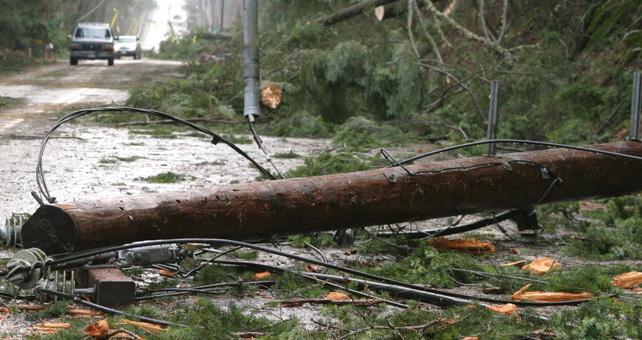
Columbia River Fire & Rescue
270 Columbia Blvd., St. Helens
503-397-2990
crfr.com
Columbia River Fire & Rescue Stations
• St. Helens Station
105 S. 12th St., St. Helens
• Rainier Station
211 West 2nd St., Rainier
• Fairgrounds Station
58798 Saulser Rd., St. Helens
• Deer Island Station
33710 Canaan Rd., Deer Island
• Columbia City Station
405 E St., Columbia City
• Goble Station
69321 Nicolai Rd., Rainier
• Fern Hill Station
73153 Doan Rd., Rainier
Put together a basic emergency supply kit with the items listed below. Find additional suggestions at crpud.net/kit.

• 1 gallon of water per person per day for at least 3 days
• At least a 3-day supply of non-perishable food items that require little or no cooking
• Flashlight, radio, and fresh batteries
• Battery-operated clock
• Lantern or candles and matches
• Blankets, sleeping bags, and warm clothes
• Camp stove or barbecue for outdoor cooking
• First aid kit
• Prescription medication
• Playing cards, games, and books to help pass the time
• Cell phone, charger, and extra battery
Clatskanie Rural Fire Protection District

280 SE Third St., Clatskanie
503-728-2025
clatskaniefire.org
Clatskanie Rural Fire Protection District Stations
• Delena Station
76015 Atkins Rd., Clatskanie
• Quincy Station
79704 Quincy Mayger Rd., Clatskanie
Scappoose Rural Fire Protection District
52751 Columbia River Hwy., Scappoose 503-543-5026
srfd.us
Vernonia Rural Fire Department
555 E. Bridge St., Vernonia 503-429-8252
vernoniafpd.us
Utilities
Columbia River PUD 64001 Columbia River Hwy., Deer Island 503-397-1844
crpud.net
Clatskanie PUD
495 E. Columbia River Hwy., Clatskanie 503-728-2163
clatskaniepud.com
Western Oregon Electric Cooperative, Inc. 652 Rose Ave., Vernonia 503-429-3021
westoregon.org
At
503-728-2163 clatskaniepud.com Stay
Did you know that wildfires can move at speeds of up to 14 miles an hour?
Oregon and Washington are prone to deadly wildfires. Droughts and dry conditions throughout the year increase wildfire risk. Careless use of fire in highly wooded areas can also dramatically increase the chance of a wildfire, which can then quickly spread across trees and dry brush and threaten homes and businesses in the vicinity. Before
• Learn about the wildfire risks in your area.
• Make an escape plan and build a kit.
• Clear leaves and other vegetative debris from roofs, gutters, porches and decks.
• Screen-in areas below patios and decks with wire mesh to prevent debris and combustible materials from accumulating.
• Remove flammable materials (wood piles, propane tanks, etc.) from within 30 feet of your home’s foundation and outbuildings, such as garages and sheds. If it can catch fire, don’t let it touch your house, deck or porch.
• Prune trees so the lowest branches are 6 to 10 feet from the ground.
• Choose building materials and plants that resist fire.
• Identify and maintain an adequate water source outside your home, such as small pond, cistern, well or swimming pool.
• Gather household items that can be used as fire tools such as a rake, ax, saw, bucket and shovel.
• Keep a garden hose that is long enough to reach any area of the home and other structures on the property. During
• Be ready to leave at a moment’s notice.
• Listen to local radio or television stations for the latest emergency information.
• Gather an emergency supply kit and be ready to leave.
• Arrange for temporary housing at a friend or relative’s home outside the threatened area.
• Confine pets to one room so you can
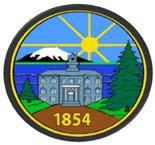

find them if you need to evacuate quickly.
• Watch for and listen to air quality reports and health warnings about smoke.
• Keep indoor air clean by closing windows and doors to prevent outside smoke from getting in.
• Use the recycle or recirculate mode on the air conditioner in your home and/ or car.
• When smoke levels are high, do not use anything that burns or adds to indoor air pollution, such as candles, fireplaces and gas stoves. Avoid vacuuming.
• If you have asthma or another lung disease, follow your health care provider’s advice.
• Dress to protect yourself; wear cotton/ woolen clothing including long sleeved shirts, long pants and gloves.
• Back your car into your garage for easier evacuation.
If Outdoors
• If you are trapped outdoors, crouch in a pond, river or pool.
• Do not place wet clothing or bandanas over your nose or mouth. After
• Let friends and family know you’re safe.
• Do not re-enter your home until fire officials say it is safe to do so.
• Use caution when entering burned areas as hazards may still exist, including hot spots that can flare up without warning.
• Avoid damaged or fallen power lines, poles and downed wires.
• Wear leather gloves and heavy soled shoes to protect hands and feet.
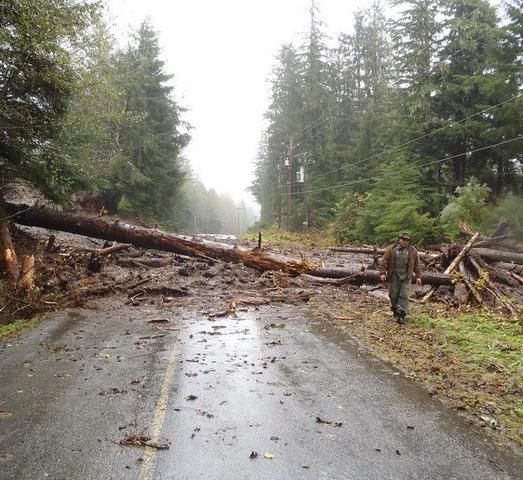
THE ROAD IS CLOSED FOR A REASON! TO KEEP YOU SAFE!
Non-Emergency Dispatch
503-815-1911
Adventist Health
Tillamook
503-842-4444
1000 Third St.
Tillamook, OR 97171
Adventist Health
Tillamook Medical Office – Plaza
503-842-5546
1100 Third St.
Tillamook, OR 97141
Care Inc.
503-842-5261
2310 First St. #2
Tillamook, OR 97141
Oregon Poison Center 800-222-1222
Tillamook Ambulance
503-815-2369
1000 Third St.
Tillamook, OR 97141
Tillamook County Emergency Management
503-842-3412
201 Laurel Ave.
Tillamook, OR 97141
Tillamook County Sheriff’s Office
503-842-2561
5995 Long Prairie Rd.
Tillamook, OR 97141
Oregon State Police 503-842-2899
If you are having an emergency, please call 9-1-1 immediately.
Tillamook Police Department
503-842-2522
207 Madrona Ave.
Tillamook, OR 97141
Tillamook Fire District
503-842-7587
2310 4th St.
Tillamook, OR 97141
Tillamook People’s Utility District
503-842-2535 or 800-422-2535
1115 Pacific Ave.
Tillamook, OR 97141
Emergency after hours:
503-842-2122
NORTH COUNTY Manzanita Police Department
503-368-7229
Adventist Health –Manzanita Primary & Specialty Care
503-368-6244
10445 Neahkahnie Creek Rd. Manzanita, OR 97130
Nehalem Bay Fire and Rescue
503-368-7590
36375 Hwy 101 N. Nehalem, OR 97131
Nehalem Bay Health Center
230 Rowe St. Wheeler, OR 97147
800-368-5182
Rockaway Beach Fire Department
503-355-2291
270 S. Anchor St. Rockaway Beach, OR 97136
CENTRAL COUNTY
Bay City Fire Department
503-377-0233
9390 4th St. Bay City, OR 97107
Garibaldi Fire & Rescue
503-322-3635
107 6th St.
Garibaldi, OR 97118
Netarts-Oceanside Fire & Rescue
503-842-5900
1235 5th St. Loop W. Tillamook, OR 97141
SOUTH COUNTY
Adventist Health Medical Office –Pacific City
503-965-6555
38505 Brooten Rd. Pacific City, OR 97135
Nestucca Rural Fire Protection District
503-392-3313
30710 Hwy 101 S. Cloverdale, OR 97112
Atrip to the beach should be fun. Unfortunately, many people are injured or killed along our nation’s beaches by hazardous sneaker waves, rip currents and high surf.
On the Oregon Coast, many people have died along the beaches from the ocean’s unpredictable fury. Many more have been injured. Their stories are tragic tales of being dragged out with the tide, being rolled over by a log or getting stuck in a current that pulled them out to sea.
For much of the West Coast, sneaker waves kill more people than all other weather hazards combined.
It’s important to be informed about what you
need to stay safe on beaches and in coastal areas and surf zones so you leave the beach with good memories.

They´re called sneaker waves because they appear without warning, often surging more than 150 feet up on the beach with deadly force, and they are impossible to predict. Sneaker waves also carry a large amount of sand that can saturate your clothes, weighing you down and making escape difficult if not impossible.
The ocean is strong enough to pick up even the biggest log and plop it down on top of you. Some logs may look small, but even the
tiny ones can be waterlogged and weigh tons. If you see a log in the surf or on wet sand, stay off it. Individuals who are dragged off the beach into the frigid waters of the Northwest are in danger of becoming victims of cold water paralyses, which can affect the limbs within minutes.
Rip currents are strong currents of water that rush out to sea. They are stronger
than even the best swimmer. These currents can swiftly sweep unwary beachcombers and waders off their feet and out to sea.
Parents, keep your kids close when playing in the ocean. If caught in a rip current, don’t panic. Swim parallel to the beach until you are out of the current, then head for the beach.
Rip currents may appear as dark, choppy water. Any time you see debris and foam floating out to sea, chances
are you have found a rip current. Avoid the area.
Incoming tides isolate rocks from headlands and the shore. Avoid the temptation of strolling out to an interesting rock without knowing when the tide rolls back in.
Free tide tables are readily available at state park offices, information centers and many shops and motels. Stay off rocks and small, enclosed beaches. Tides and waves can sweep over rocks, jetties and headlands, knocking you off and carrying
• SIDING
• WINDOWS
• DECKS
• CUSTOM
NEW BUILDS
• POLE BARNS
• CONCRETE
Continued from Page 6
you out to sea.
Assume nothing is “high enough,” and avoid exposed rocks, jetties and headlands during strong wave action.
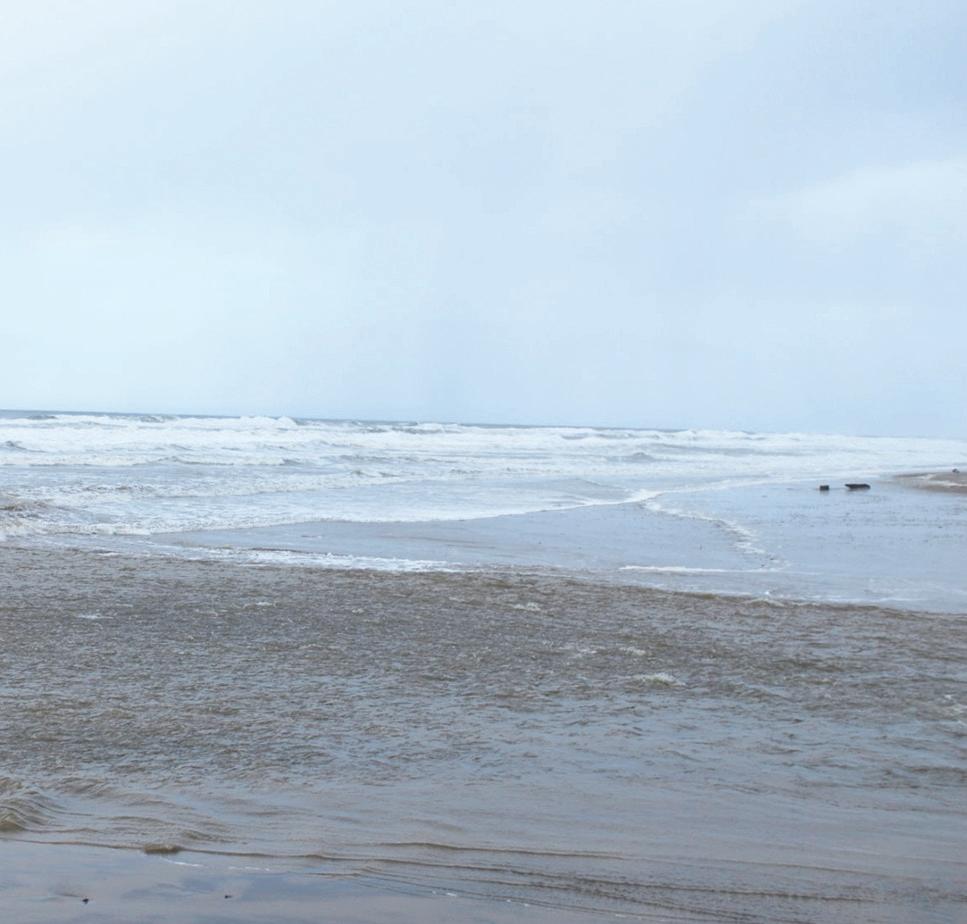
Assume that all cliff edges are unstable. Wet trails or soft sand and earth can make for unstable footing. Rocks can be slippery even when it isn’t raining. Make sure you wear proper footwear, and stick to the trails.
Stay behind guard fences and railings, and don´t get too close to the edge. Standing at the base of an oceanside cliff can be dangerous, especially if it has an overhang. In some places, winter storms and high waves have eroded the shoreline, increasing the chance of collapse and slides.
• Constantly watch the ocean for changes in wave patterns. Watch the ocean for at least 20 minutes to get a feel for the pattern before relaxing or playing on the beach.
• Know the local forecast for the day. Look to see if there are statements regarding sneaker waves, high surf or other beach hazards.
• Stay farther back from the ocean than you think is necessary.
• Never sit or stand on logs on the beach.
• Never turn your back on the ocean.
• If you do get swept up into the ocean, don’t try to fight the current. Instead conserve energy and focus on keeping your head above water until rescuers arrive. Bystanders should never enter the ocean to make a rescue, but should instead call 911 and keep visual contact with victims.
GAGE Contractors are experts for all your exterior needs. The rainy, windy weather on the coast can wreak havoc on our homes. We can help you identify if there are signs of water or rot damage already occurring in windows and siding or help you assess the safety of decks or exterior stairs. If you have issues you are concerned with and need repairs or are looking to build with the proper materials and craftsmanship, we are happy to come and talk with you… always FREE estimates.
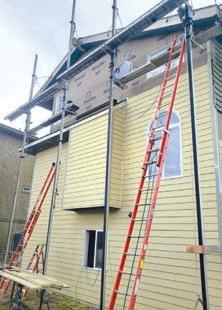
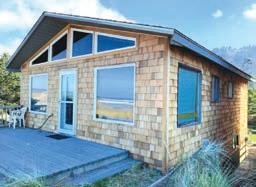


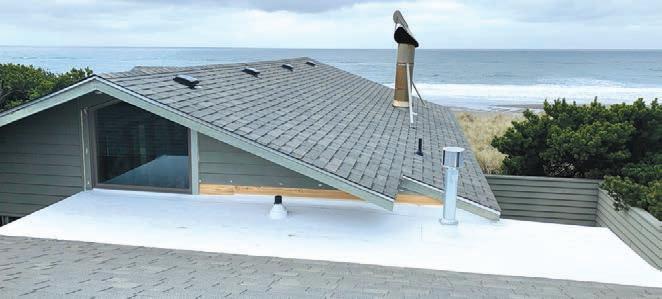
Jacob and Heidi Holzgrafe
CCB# 240117
Did you know that during a major earthquake you may be without utilities for weeks or even months?
• Make an escape plan and build a kit.
• Identify safe places in each room of your home, workplace and/ or school. A safe place could be under a piece of sturdy furniture or against an interior wall away from windows, bookcases or tall furniture that could fall on you.
• Practice “drop, cover and hold on” in each safe place. If you do not have sturdy furniture to hold on to, sit on the

floor next to an interior wall, and cover your head and neck with your arms.
• Keep a flashlight and sturdy shoes by your bed in case an earthquake strikes in the middle of the night.
• Make sure your home is securely anchored to its foundation.
• Bolt and brace water heaters and gas appliances to wall studs.
• Bolt bookcases, china cabinets and other tall furniture to wall studs.
• Hang heavy items, such as pictures and mirrors, away from beds, couches and anywhere people sleep or sit.
• Brace overhead light fixtures.
• Install strong latches or
bolts on cabinets. Large or heavy items should be close to the floor.
• Learn how to shut off the gas valves in your home and keep a wrench handy for that purpose.
• Learn about your area’s seismic building standards and land use codes before you begin new construction.
If you are inside when the shaking starts
• Drop, cover and hold on. Move as little as possible.
• If you are in bed, stay there, curl up and hold on. Protect your head with a pillow. Don’t try to get under your bed.
• Stay away from windows to avoid being injured by shattered glass.
• Stay indoors until the shaking stops and you are sure it is safe to exit. When it is, use stairs rather than an elevator in case there are aftershocks, power outages or other damage.
• Be aware that fire alarms and sprinkler systems frequently go off in buildings during an earthquake, even if there is no fire, but take appropriate precautions if an alarm sounds.

If you are outside when the shaking starts
• Find a clear spot (away from buildings, power lines, trees, streetlights, etc.) and drop to the ground. Stay there until the shaking stops.
• If you are in a vehicle, pull over to a clear location, and stop. Avoid bridges, overpasses and power lines if possible. Stay inside your vehicle with your seatbelt fastened until the shaking stops. Then, if you can, drive carefully, avoiding
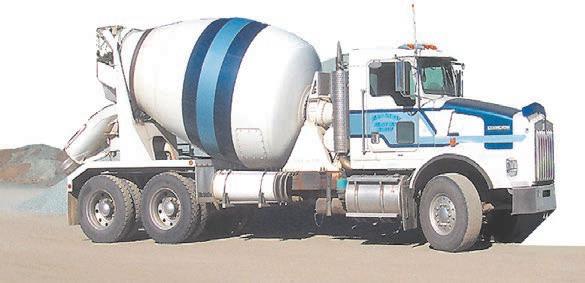





bridges and ramps that may have been damaged.
• If a power line falls on your vehicle, do not get out. Wait for assistance.
• If you are in a mountainous area or near unstable slopes or cliffs, be alert for falling rocks and other debris.
• Landslides are often triggered by earthquakes.
• After an earthquake, the disaster may continue. Expect and prepare for potential aftershocks, landslides or even a tsunami.
• Look for and extinguish
small fires. Fire is the most common hazard after an earthquake.
• Each time you feel an aftershock, be sure to drop, cover and hold on. Aftershocks frequently occur minutes, days, weeks and even months following an earthquake.
• Check yourself for injuries and get first aid, if necessary, before helping injured or trapped persons.
• Put on long pants, a long-sleeved shirt, sturdy shoes and work gloves to protect against injury from broken objects.

Call









503-368-5157

Continued from Page 3
these supplies in easyto-carry containers or go-bags in case you need to evacuate quickly.
Disasters can strike at any time. They don’t wait for you to be ready.
Taking simple steps will help you and your loved ones be better prepared when the next emergency arrives. The Oregon Department of Emergency Management offers a free Emergency Pocket Plan publication that helps you develop your emergency plan.
Request a copy from your county or tribal
emergency management office.
Take care, Matt Garrett
Matt Garrett is the Interim Director of the Oregon Department of Emergency Management. The department may be reached at 503-3782911.
Did you know that landslides take place most often where they’ve occurred in the past? They’re also more common in areas that have recently been burned by a wildfire.
Before
• Make an escape plan and build a kit.
• Be aware of warning signs of possible landslides:
> Increased pooling of water or newly wet ground.

> New cracks or unusual bulges in the ground, street pavements or sidewalks.
> Soil moving away from foundations.
> Tilted or bent trees.
> Sagging or taught utility lines.
> Sunken or broken road beds.
> Leaking or broken water pipes.
• Reduce the chances of landslides by:
> Draining water from surface runoff, downspouts and driveways well away from slopes.
> Planting native groundcover on slopes.
> Refraining from adding water to steep slopes.
> Avoiding placing fill soil and yard debris on steep slopes.
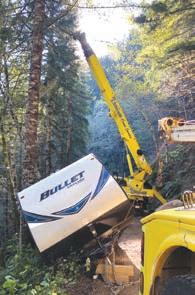
During
• If you suspect imminent danger, evacuate immediately. Inform affected neighbors if you can, and contact your public works, fire or police department.
• Listen for unusual sounds that might indicate moving debris, such as trees cracking or boulders hitting one another.
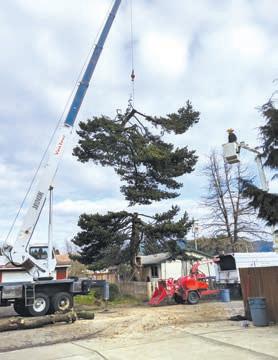
• If you are near a stream, be alert for any sudden increase or decrease in water flow and notice whether the water changes from clear to muddy. Such changes may mean there is debris flow activity upstream so be prepared to move quickly.
• Be especially alert when driving— watch for collapsed pavement, mud, fallen rocks and other indications of possible debris flow.

• If you are ordered to or decide to evacuate, take your animals with you.

• Stay away from the slide area. There may be danger of additional slides.
• Check for injured and trapped persons near the slide without entering the direct slide area. Direct rescuers to the person’s location.
• Listen to local radio or television stations for the latest emergency information.
• Watch for flooding, which may occur after a landslide or debris flow. Floods sometimes follow landslides and debris flows because they may be started by the same event.
• Look for and report broken utility lines to appropriate authorities. Reporting potential hazards will get damaged utilities turned off as quickly as possible, preventing further hazard and injury.
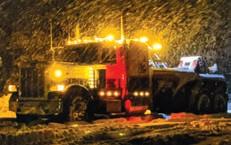
• Check the building foundation, chimney and surrounding land for damage. Signs of damage may help you assess the safety of the area.
• Replant damaged ground as soon as possible since erosion caused by loss of groundcover can lead to flash flooding.
Additional information about landslides is available on the Oregon Department of Geology and Mineral Industries (oregongeology.org) and the Washington Department of Natural Resources (dnr. wa.gov) websites.
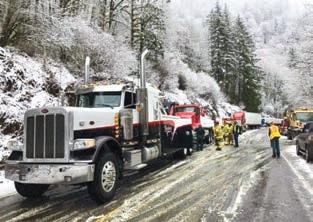
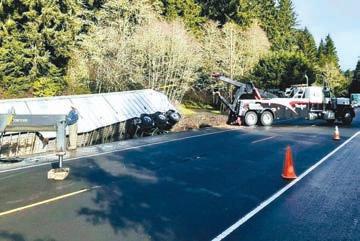
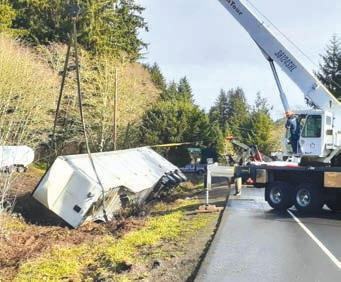
• If the water looks too don’t go through it
• Coast KDEP 105.5 FM
• KTIL 95.5FM • KTIL 1590 AM
• Road & weather info dial 511 or 1-800-977-6368
• TripCheck.com or Tripcheck.com/mobile for road conditions
• Know your cell phone # and location
• Ask your insurance agent to add towing & Roadside Service to your insurance policy for your piece of mind
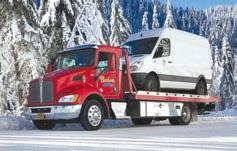



The states in the U.S. at greatest risk of tsunamis are Alaska, California, Hawaii, Oregon and Washington.
Tsunamis are series of large ocean waves caused by major earthquakes or landslides beneath the ocean. When the waves enter shallow water, they may rise several feet or, in rare cases, near 100 feet, striking the coast with devastating force.
Tsunamis can be local or distant. A local tsunami can arrive within minutes of an earthquake. A distant tsunami can take four to 12 hours to arrive on shore. If you feel the ground shake while at the beach or a low coastal area, move on foot inland and to higher ground as quickly as possible.
• Find out if your home, school, workplace or other frequently visited locations are in tsunami hazard areas.
• Make an escape plan and build a kit.
• Plan evacuation routes from your home, school, workplace and other places you could be where tsunamis present a risk. If possible, choose evacuation locations 100 feet above sea level. If you cannot get this high, go as high as you can. You should be able to reach your safe location on foot within 15 minutes.
• Learn the evacuation plan where your child attends school. Find out if the plan requires you to pick your children up from school
or from another location. During a tsunami watch or warning, telephone lines may be overloaded and routes to and from schools may be jammed.
• Practice your evacuation routes. Familiarity may save your life. Be able to follow your escape route at night and during inclement weather. Practicing your plan will allow you to jump into action during an actual emergency.
• When visiting the coast, familiarize yourself with the nearest tsunami evacuation routes. During
• If an earthquake occurs while you are on the coast and indoors, drop, cover

and hold on. If you are outdoors, avoid falling objects.
• When the shaking has stopped, move quickly inland and to higher ground. Go on foot if possible.
• Take a pre-prepared gobag filled with emergency supplies, but don’t delay leaving.
• If a tsunami watch is issued, listen to a NOAA weather radio, a Coast Guard emergency frequency station or other reliable sources for updated emergency information. Be ready to evacuate.
• Remain inland and on higher ground until an “all clear” announcement is made by local officials.
• Continue listening to a NOAA weather radio, a Coast Guard station or a local radio or television station for the latest updates.






• Return to lower ground only after local officials tell you it is safe to do so. A tsunami may consist of a series of waves and could continue for hours. Do not assume that after one wave the danger is over. The next wave may be larger than the first one.
• Check yourself for injuries and get first aid as needed before helping injured or trapped persons.
• If someone needs to be rescued, call professionals who have the right
Power outages are most commonly caused by bad weather, trees contacting electric lines or equipment, motor vehicle crashes affecting electric equipment, equipment failure or damage caused by animals. Faulty wiring and equipment in your buildings can also cause a localized power outage. Investigate your home or business to determine if any electrical hazards are present. If there are, notify
equipment to help. Many people have been killed or injured trying to rescue others.
• Assist people with access and functional needs who require assistance, such as infants and children, as well as the elderly, the disabled and those without transportation.
• Avoid disaster areas. Your presence might interfere with emergency response operations and put you at further risk from the residual effects of the tsunami.
• Use texts to communicate with friends or family. Phone calls should only be made if absolutely necessary.

• Stay out of buildings surrounded by water. Tsunami water can cause floors to crack or walls to collapse.
• Use caution when reentering buildings or homes.
Tsunami evacuation maps and other resources are available at nvs.nanoos. org/TsunamiEvac.
your local power company. If you see or smell any signs of an electrical flash or fire, call 911.
Look to see if your neighbors are also without power. Streetlights may be the best indication of this.



Prepare in advance: assemble an emergency preparedness kit, with supplies such as water, non-perishable food, a flashlight, extra batteries,
first aid kit and more; create a household evacuation plan that includes your pets; and stay informed abut your community’s risk and response plans. Protect yourself during a power outage: keep freezers and
Oregon follows a 3 Level evacuation notification system, each structured around the readiness need and threat level. Know the current levels and what they mean to help make the best decision to stay safe. Don’t wait to evacuate if you feel unsafe.
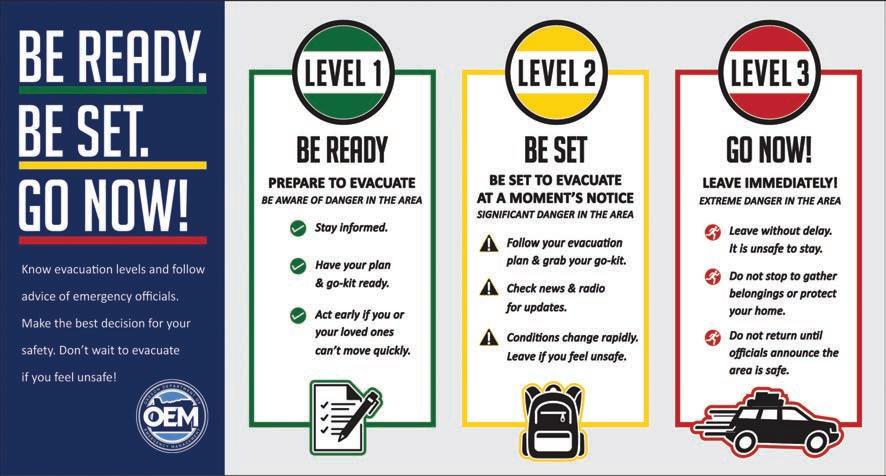
Levels
• (Green on a map) LEVEL 1 - BE READY to evacuate.
Be aware of danger in the area. Stay informed: Sign up for emergency alerts with your county. Check the county emergency management website and follow local emergency services on social media for updates (county, sheriff’s office, fire agencies). Tune in to local news for more information. This is the time to pack and prepare to leave. Have your emergency plan and go-kit ready. Plan possible evacuation routes and transportation needs. Check with loved ones and emergency contacts. If you can do
so safely, check with your neighbors, share information and ask for help if needed. Consider leaving early if you or your loved ones can’t move quickly and need more time to evacuate, including older adults, families with children, people with disabilities and those with limited access to transportation. Consider moving pets and livestock early.
• (Yellow on a map) Level 2 - BE SET to evacuate.
There is significant danger in the area. Be prepared to leave at a moment’s notice. Time to act - there may not be enough time to pack your belongings and doing so is at your own risk. Leave if you or your loved ones can’t move quickly and need extra time to evacuate. Inform loved ones of your evacuation plans. Be prepared to relocate to a shelter or with family or friends outside of the affected area. Stay informed and be alert. Continue to check the county emergency management
website, local emergency services on social media, and local news for updates. Conditions can change rapidly. Leave if you feel unsafe. You don’t need to wait for another evacuation notice.
• (Red on a map) Level 3 - GO NOW! Leave immediately! There is extreme danger in the area. It is unsafe
to stay and threatens the safety of you, your loved ones and emergency responders. Do not stop to gather belongings or make efforts to protect your home. Emergency responders may not be available to provide help if you choose to stay. Do not return to the area until officials announce the area is safe.
Continued from Page 10
refrigerators closed, only use generators outdoors and away from windows and understand the risks of carbon monoxide poisoning, do not use a gas stove to heat your home, disconnect appliances and electronics to avoid damage from
electrical surges, and check on neighbors, use flashlights instead of candles, eliminate unnecessary travel.

To keep your food from spoiling during a power outage, keep a cooler, ice and a digital thermometer on hand. Have at least a half tank of gas in your car and fill extra containers. If power is out for an extended
time, gas supply may be limited.
Be safe after: throw away food that has been exposed to temperatures 40 degrees or higher for two hours or more, or that has an unusual odor, color or texture; if the power is out for more than a day, discard any medication that should be refrigerated, unless the drug’s label says
otherwise.
If electrical power lines are down, do not touch them. Report downed lines to your utility company.
To report a power outage, call your local electric service.
Information was gathered from Tillamook PUD, Department of Homeland Security, and American Red Cross.

You’re made for more. More helping out. More showing up. More working together to build healthy families and futures. That’s why Adventist Health Tillamook is here for our community. We know that when we work together, our community can face any challenge. That’s why our vision goes beyond the physical walls of our facilities to transform the health and well-being of our community today and for generations to come. Because now more than ever, it’s important for us to stay connected.
To learn more about staying healthy, active and connected, visit AdventistHealthTillamook.org


Locations near you!
Medical Office – Manzanita +
503-368-6244
10445 Neahkahnie Creek Rd.
Manzanita
Medical Office – Plaza +
503-842-5546
1100 Third St.
Tillamook
Women’s and Family Health
503-815-2100
1011 Third St.
Tillamook
Medical Office – Pacific City
503-965-6555
38505 Brooten Rd., Suite A Pacific City
Medical Office – Lincoln City +
541-614-0482
1105 SE Jetty Ave., Suite C
Lincoln City
+ Urgent care – come right in!